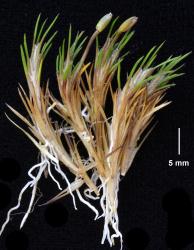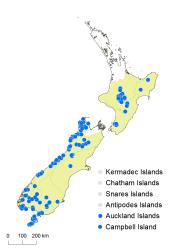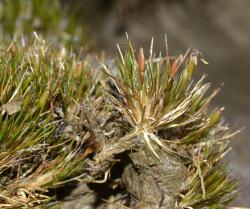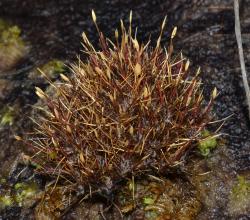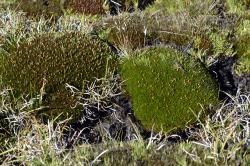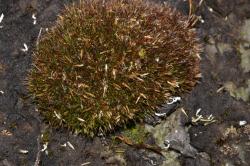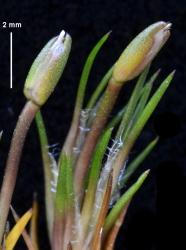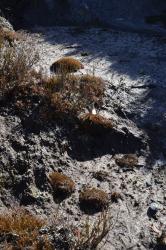- Taxon
- Gallery
- ≡ Gaimardia ciliata Hook.f., Bot. Antarct. Voy. I. (Fl. Antarct.) Part I, 85 (1844)
- ≡ Alepyrum ciliatum (Hook.f.) Hieron. in Engler & Prantl, Nat. Pflanzenfam.II, 4, 14 (1888)
- ≡ Pseudalepyrum ciliatum (Hook.f.) Dandy, J. Bot. 70: 331 (1932)
- = Centrolepis viridis var. ligulata Kirk, Trans. New Zealand Inst. 23: 442 (1891)
- ≡ Gaimardia ciliata var. ligulata (Kirk) Cheeseman, Man. New Zealand Fl., ed. 2, 289 (1925)
- ≡ Pseudalepyrum ciliatum var. ligulatum (Kirk) Dandy, J. Bot. 70: 331 (1932)
- = Centrolepis viridis (Kirk) Kirk, Trans. New Zealand Inst. 23: 441 (1891)
Perennial cushion, 5–100 mm high. Stems ascending, branching. Leaves crowded, obscurely distichous, cauline and imbricate, weakly spreading to erect. Leaf-sheath 2.5–6 mm long, scarious, with multicellular hispid hairs. Leaf-sheath auricles lobed or absent; ligulate, sometimes minute or occasionally pilose. Leaf-lamina 2.5–23 × 0.4–0.7 mm, subulate, with an acute or acicular apex, terete to faintly channelled, glabrous or with pilose hairs below. Uppermost leaf, leaf-like or reduced to a membranous cataphyll. Flowering stems 3.5–20 mm long, glabrous. Inflorescence a compressed ellipsoid to oblong spike, 2.6–5 × 1–1.5 mm. Outer primary floral bract 2.6–5 mm long, elliptic and contracting to an incurved or straight foliar point; papillate. Inner floral bract, 2–4 mm long, elliptic to oblong contracting to an incurved or straight foliar point; papillate. Primary bracts separated by an internode 0.2–0.8 mm long. Secondary hyaline scales present, 1/reproductive unit. Reproductive units/spike 2–3(–5) all bisexual or 1–2 bisexual the rest female. Androecium 1 stamen; filament capillary, 3–7 mm long; anthers fusiform, 0.96–1.6 mm long. Gynoecium, 1–2–(3) connate, superposed carpels. Styles stigmatic with branched papillae, crimson. Seeds 0.75–1 × 0.3–0.5 mm, ellipsoid, yellow to yellow-brown or brown, striated.
Distinguished from the two other cushion bog centrolepids with which it can occur, Centrolepis pallida and Gaimardia setacea, by hairy leaf-sheaths, both primary inflorescence bracts contracted to mucronate foliar points, and the presence of secondary hyaline scales within the primary floral bracts.
North Island: South Auckland (Hauhungaroa Range, Raukūmara Range, Kaimanawa, Tongariro, National Park, Urewera National Park), Taranaki, Volcanic Plateau, Wellington (Ruahine and Tararua ranges).
South Island: Nelson, Marlborough, Westland, Canterbury, Otago, Southland, Fiordland.
Stewart Island, Auckland Islands, Campbell Island.
Montane to alpine bogs, flushes, turfs, tarn edges, pakihi and wet heathlands to 1600 m a.s.l., descending to sea-level in the south and west of the South Island in lowland pakihi, peat bogs and oligotrophic swamps.
Flowering: Nov.-Jan.
Plants on the New Zealand mainland have inflorescence bracts with distinctive incurved foliar points whereas plants from the Auckland and Campbell islands have foliar points more-or-less straight.



